Umbrellas and Airplanes?

Missionary Ed Casteel was about to discover a strange connection.
In 1978, 24-year-old Ed had just taken “the most grueling hike” of his life. The two and a half days of rigorous trekking came as the last leg of a week-long trip using six types of transportation. And it was all to contact the Wana tribe of Asia-Pacific. Clearly, “if we were ever to reach these people we would have to have some sort of an aircraft to do so,” says Ed.
After the Wana warmly welcomed them, Ed explained the team’s reason for coming: to bring the Gospel, to teach the people to read and write, and to help them economically. But they’d need the Wana to build them an airstrip and houses so they could bring their families. The Wana readily agreed.
“We told them that if they were serious, then they should cut the grass where we would build a short airstrip, and [they also needed to] build a house for us to stay in while we were working on the airstrip,” recalls Ed. The villagers would have until after Christmas, when the team would fly over the area and see if it was done.
First, an Airstrip
At the appointed time, Ed and his teammates flew over the village. “Much to our surprise they had indeed cut a place for an airstrip, and a small house had also been built.” To acknowledge the work, the missionaries air-dropped shovels they had brought with them on the flight.
In March 1979, pilot Scott Wolfe hiked in with the team to help complete the airstrip. Astonishingly, one hundred Wana men showed up to help. They cleared the ground, weaving baskets from coconut leaves to move dirt and level the strip. In only three days, they built a crude 210-meter strip, just long enough for a Super Cub to land.
Before hiking back out, the missionaries requested more work: Could the Wana people build them some simple jungle houses to live in when they came back with their families?
In April of 1979, Scott flew in to test the airstrip. Amazingly, the Wana had indeed built houses for the missionaries – even having to rebuild one after a landslide destroyed it.
In June, Casteels and another family moved in, followed by a third family in July. “It was primitive living for sure,” recollects Ed, “as we had to build out-houses, wash and bathe in the stream, and haul water in buckets to our house.”
An Amazing Story
Once a month, the team flew a medical worker into the village to treat the malaria, dysentery, and leprosy among the people. This medical worker was fluent in Wana and understood the culture, so Ed asked a question that had been perplexing him: Why had the people been so very receptive and helpful in building the airstrip and houses – and all free of charge? Here’s the story he heard:
One day two white men came flying in to Wana on a wide brimmed garden hat (which they refer to as an “umbrella” due to its large size). The Wana were convinced that these two white men were there to bring back the riches and knowledge that they had lost.
These two white men clearly did not like noise at all. But one day, a Wana man dropped his load of firewood, causing a loud crashing sound.
This disturbed the two white men, so they got on their umbrella and flew away – much to the dismay of the Wana people. However, they believed that one day these men would return on their umbrella to bring wealth and knowledge back to the Wana.”
Aha! Now it made sense. “They were sure we were those umbrella men returning to bring them the wealth and knowledge they had been waiting for, and thus they were elated to welcome us to their village!” says Ed.
God had used the airplane to give not only physical entrance to the team but also, as the “umbrella,” to give them a cultural connection to the Wana people group.
The good reception continued, and the people supplied the missionaries with rice and vegetables while helping them learn the language. After two years, Ed and his coworker could speak well enough to teach. And by God’s grace, the Wana finally found true wealth and knowledge.

Now, the Wana themselves use the “umbrella” (no longer a Super Cub, but a helicopter!) to gain entrance to new villages, bringing the riches of Christ. Your gifts to sponsor Ethnos360 Aviation flight costs ensure that this tool is available to them, making outreach feasible.
